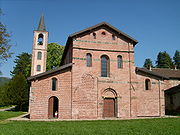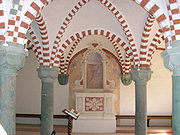
Tiglieto Abbey
Encyclopedia

Tiglieto
Tiglieto is a comune in the Province of Genoa in the Italian region Liguria, located about 52 km northwest of Genoa.Tiglieto borders the following municipalities: Campo Ligure, Genoa, Masone, Molare, Ponzone, Rossiglione, Sassello, Urbe.-History:In 1120 Tiglieto Abbey was the first...
, Liguria
Liguria
Liguria is a coastal region of north-western Italy, the third smallest of the Italian regions. Its capital is Genoa. It is a popular region with tourists for its beautiful beaches, picturesque little towns, and good food.-Geography:...
, northern Italy
Italy
Italy , officially the Italian Republic languages]] under the European Charter for Regional or Minority Languages. In each of these, Italy's official name is as follows:;;;;;;;;), is a unitary parliamentary republic in South-Central Europe. To the north it borders France, Switzerland, Austria and...
. It was the first Cistercian abbey to be founded in Italy
Italy
Italy , officially the Italian Republic languages]] under the European Charter for Regional or Minority Languages. In each of these, Italy's official name is as follows:;;;;;;;;), is a unitary parliamentary republic in South-Central Europe. To the north it borders France, Switzerland, Austria and...
, and also the first outside France
France
The French Republic , The French Republic , The French Republic , (commonly known as France , is a unitary semi-presidential republic in Western Europe with several overseas territories and islands located on other continents and in the Indian, Pacific, and Atlantic oceans. Metropolitan France...
.
The abbey is located on the left bank of the brook known as the Orba
Orba (torrente)
The Orba is a torrent of northern Italy. Its c. 70 km course runs northwards through Piedmont from its springs in the Apennines to its confluence with the Bormida, a right tributary of the Po...
, 382 metres above sea level
Sea level
Mean sea level is a measure of the average height of the ocean's surface ; used as a standard in reckoning land elevation...
in the Province of Genoa
Province of Genoa
The Province of Genoa is a province in the Liguria region of Italy. Its capital is the city of Genoa.It has an area of 1,838 km², and a total population of about 900,000...
, near the border of the Region of Piedmont
Piedmont
Piedmont is one of the 20 regions of Italy. It has an area of 25,402 square kilometres and a population of about 4.4 million. The capital of Piedmont is Turin. The main local language is Piedmontese. Occitan is also spoken by a minority in the Occitan Valleys situated in the Provinces of...
.
History
The abbey, founded in 1120 at the instigation of Peter of TarentaisePeter of Tarentaise
Peter of Tarentaise was a Roman Catholic abbot and bishop. He has been declared a saint by that church, with a feast day of May 8.-Biography:...
, was a daughter house of La Ferté Abbey
La Ferté Abbey
Founded in 1113, the Cistercian abbey La Ferté was the first of the four great daughter-houses of Cîteaux. It was closed in 1791. The abbey church was demolished, but the 18th century abbatial palace remains, and can be visited. It is located 12 km south of Chalon-sur-Saône, in Bourgogne,...
. The first abbot was probably Opizzone. It may have gained the name Tiglieto after being given the estate of that name by the Margrave Anselm of Ponsone in 1131.
Communities from Tiglieto settled Staffarda Abbey
Staffarda Abbey
Staffarda Abbey is a Cistercian monastery located near Saluzzo in north-west Italy; it was founded as a daughter house of Tiglieto Abbey in 1135 by Manfred I, Marquis of Saluzzo. The abbey became an important local centre for agriculture and held a flourishing market...
and Casanova Abbey as its daughter houses, both in the present Region of Piedmont.
In 1442, through Pope Eugenius IV, Tiglieto became an abbey in commendam
In Commendam
In canon law, commendam was a form of transferring an ecclesiastical benefice in trust to the custody of a patron...
. In 1648 it was turned into a family estate of the last commendatory abbot, Cardinal Raggio, and dissolved. In 1747 the area was occupied by the Austria
Austria
Austria , officially the Republic of Austria , is a landlocked country of roughly 8.4 million people in Central Europe. It is bordered by the Czech Republic and Germany to the north, Slovakia and Hungary to the east, Slovenia and Italy to the south, and Switzerland and Liechtenstein to the...
ns, who shortly afterwards were driven out by the Genoese
Genoa
Genoa |Ligurian]] Zena ; Latin and, archaically, English Genua) is a city and an important seaport in northern Italy, the capital of the Province of Genoa and of the region of Liguria....
.
In 2000 Tiglieto was reoccupied by the Cistercians.

Buildings and precinct
The church is a primitive RomanesqueRomanesque architecture
Romanesque architecture is an architectural style of Medieval Europe characterised by semi-circular arches. There is no consensus for the beginning date of the Romanesque architecture, with proposals ranging from the 6th to the 10th century. It developed in the 12th century into the Gothic style,...
brick basilica
Basilica
The Latin word basilica , was originally used to describe a Roman public building, usually located in the forum of a Roman town. Public basilicas began to appear in Hellenistic cities in the 2nd century BC.The term was also applied to buildings used for religious purposes...
; the original side-chapels were removed in the 14th century to make way for a new east end. The nave was vaulted in the Baroque period, and a new choir at the west end was added at the same time, as was a Baroque campanile
Campanile
Campanile is an Italian word meaning "bell tower" . The term applies to bell towers which are either part of a larger building or free-standing, although in American English, the latter meaning has become prevalent.The most famous campanile is probably the Leaning Tower of Pisa...
. The conventual buildings are to the south of the church. The early Gothic chapter house
Chapter house
A chapter house or chapterhouse is a building or room attached to a cathedral or collegiate church in which meetings are held. They can also be found in medieval monasteries....
in the east range has survived, with a square chapter room with nine bays from the early 13th century and symmetrical triforium
Triforium
A triforium is a shallow arched gallery within the thickness of inner wall, which stands above the nave of a church or cathedral. It may occur at the level of the clerestory windows, or it may be located as a separate level below the clerestory. It may itself have an outer wall of glass rather than...
windows looking onto the central courtyard and the site of the cloister
Cloister
A cloister is a rectangular open space surrounded by covered walks or open galleries, with open arcades on the inner side, running along the walls of buildings and forming a quadrangle or garth...
, no longer extant, with the dormitory with bricked-up windows in the upper storey, as have the sacristy
Sacristy
A sacristy is a room for keeping vestments and other church furnishings, sacred vessels, and parish records.The sacristy is usually located inside the church, but in some cases it is an annex or separate building...
, the Fraternei and to the south the refectory
Refectory
A refectory is a dining room, especially in monasteries, boarding schools and academic institutions. One of the places the term is most often used today is in graduate seminaries...
building, as well as the lay brother
Lay brother
In the most common usage, lay brothers are those members of Catholic religious orders, particularly of monastic orders, occupied primarily with manual labour and with the secular affairs of a monastery or friary, in contrast to the choir monks of the same monastery who are devoted mainly to the...
s' block in the west, now converted for residential purposes. The entire precinct was renovated for the new community that took over the premises in 2000.

